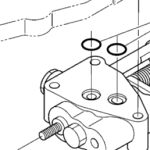If you have the proper setup by all means test pump.outlet pressure. Sounds like you know the drill so dont take offense if this is obvious to you. Its not for many people.
You hook the tester to the pump outlet pipe and run the return back into the hydraulic sump filler.
Then FULLY open the loading valve on the tester and start thr engine. With the engine running @ roughly 3/4 speed slowly start to close the loading valve while watching pressure. Pressure should start to rise and hit the target (2500+ PSI) before the loading valve is fully closed. There is no relief valve in the system when hooked up like that and you do not want to deadhead the pump by completely closing that valve.
That test will go a long way towards knowing where to look for the problem

Dan


